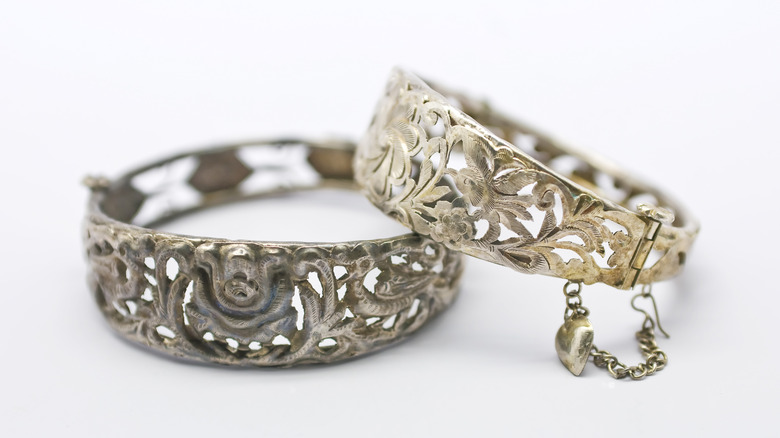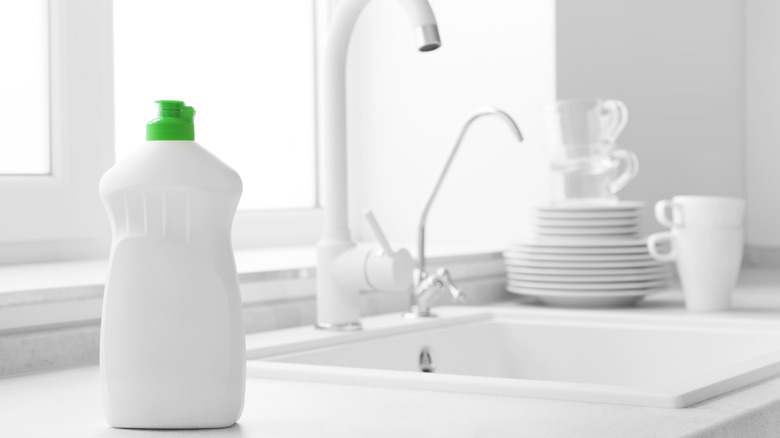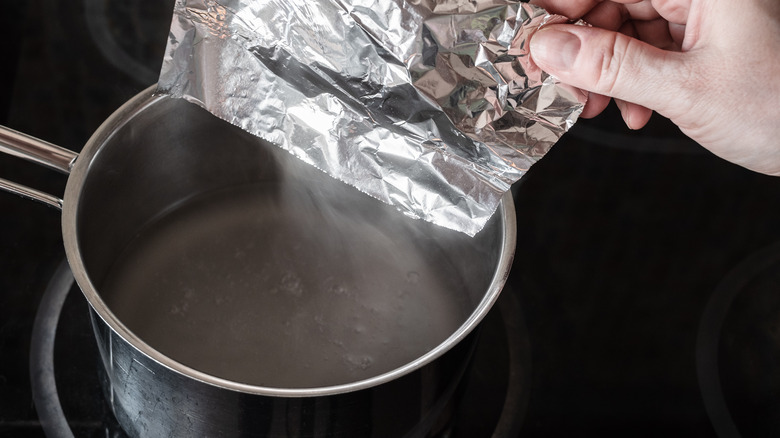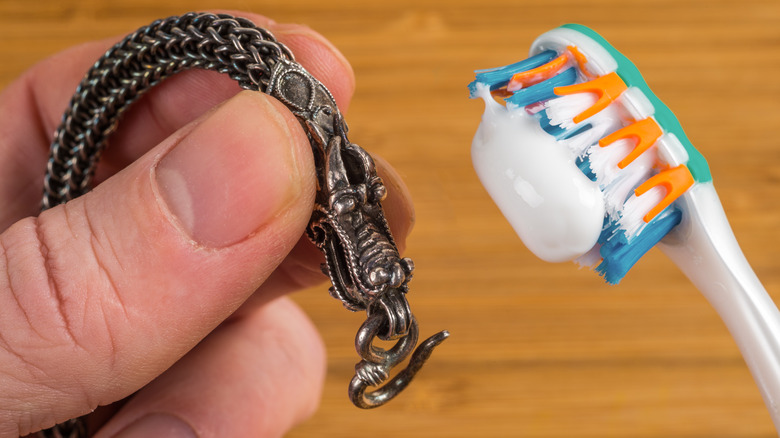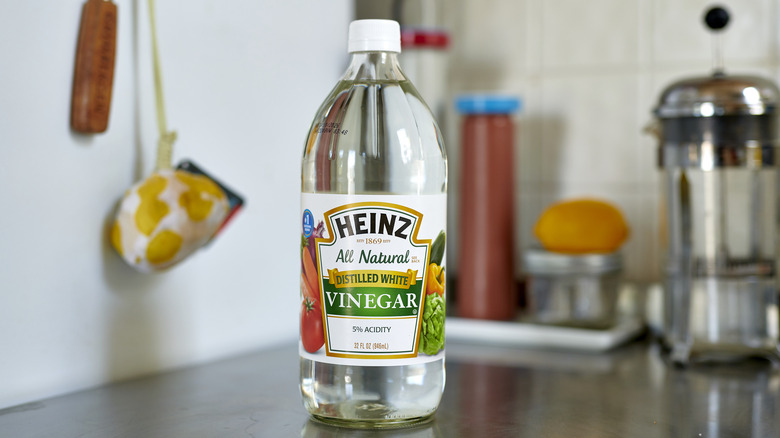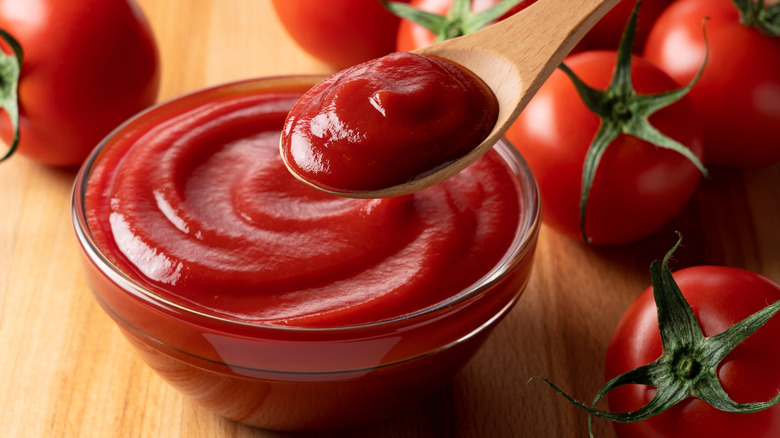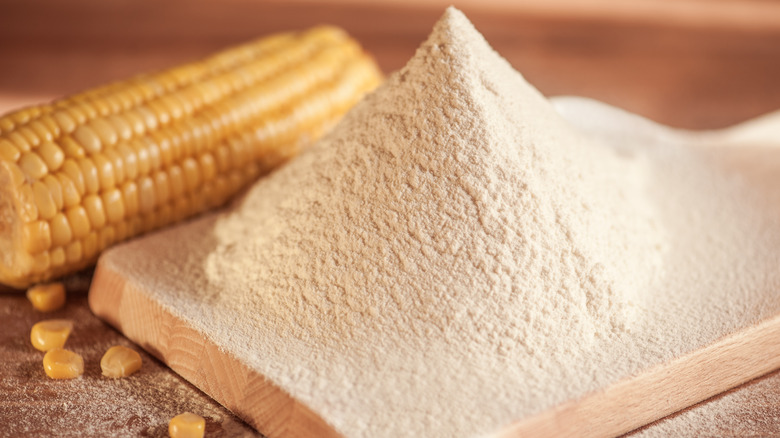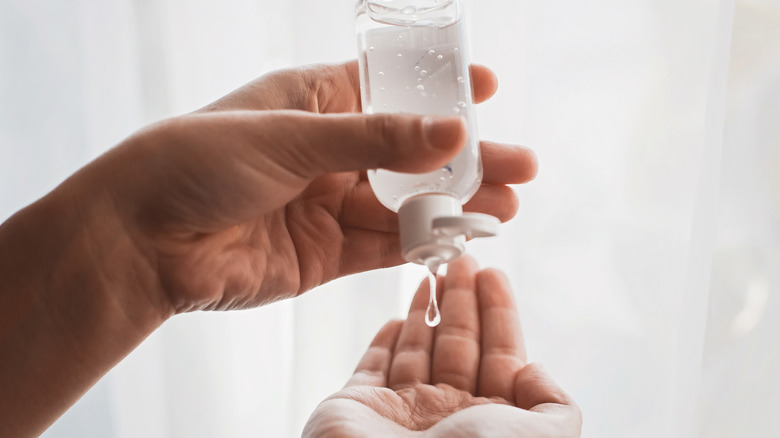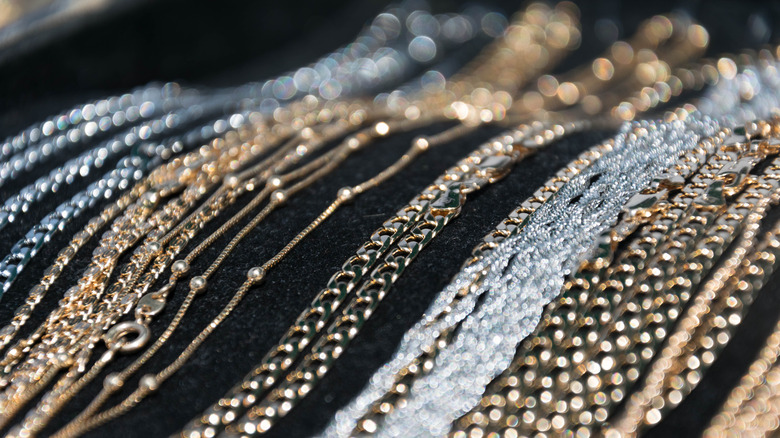Cleaning Silver Jewelry Is Super Easy - Here's How To Do It
Most people are already cleaning so many things on the regular, from floors to laundry to personal workspaces, that the idea of cleaning jewelry is just so extra. So, when faced with the option of polishing that heirloom silver piece or donning a costume necklace instead, it's totally understandable for a person to choose the latter. That said, there's no need to let silver jewelry languish unused anymore, because as it turns out it's really not difficult to get silver back to a sparkling shine.
Jewelry made from silver is literally a whole lot more precious than knockoff pieces (it's one of the four precious metals: gold, silver, palladium, and platinum). Unfortunately, it needs a bit of extra TLC, since it tarnishes when exposed to particles of sulfur and oxygen, found in the air we breathe and otherwise live in. Silver tarnishes in multiple stages, and can appear yellow, reddish-brown, and blue in color. In its final stage, it's an unsightly blackish color. While black certainly has its place in the jewelry space, it doesn't on silver.
The easiest way to clean silver jewelry
For this method, all you'll need is some gentle dish soap, a bowl of warm water, a soft-bristled toothbrush, and a microfiber cloth. First, fill a bowl with warm water. Then add a few drops of the soap to the water, and mix up until nice and bubbly. Allow your silver jewelry to soak for a time, at least five to 10 minutes. Remove the jewelry from the mixture and set aside.
Next, clean any crannies or crevices in the jewelry with the toothbrush, using it gently. Then rinse in clean, warm water. Lastly, dry the pieces gently using a microfiber towel. Bonus points if you have a silver-specific cloth! Never use a napkin or rough paper towel to dry the jewelry. This can actually scratch the silver, which would be oh-so-unfortunate! Sometimes, all it takes is a gentle hand and some household ingredients to get silver back to its original glory. Incidentally, this is all it really takes to keep tarnish from forming in the first place, so maybe make a habit of it.
The boiling water method
Another fabulous, if slightly more involved, DIY silver-cleaning method requires a little more care. If you don't have any, pick up aluminum foil, baking soda, and kosher salt from the store. Next, get the aluminum foil and line a pan or pot with it. In a separate container, boil some water. Then, pour the boiling water (carefully!) into the foil-lined pot. Then add two teaspoons of kosher salt, followed by 1/4 cup of baking soda. Stir well until bubbles start to form. Gently place silver pieces in the pan mixture, spreading them out so they don't touch anything else. Allow the water to cool completely. When it is nice and cooled down to room temperature again, remove the pieces and dry them with a microfiber cloth. This is an excellent option for rings and other small items that are difficult to effectively scrub with a toothbrush.
Time for toothpaste
In the same way that toothpaste cleans teeth, so can it clean silver! Do note, however, that this method should NOT be used on silver-plated items. To verify that it's silver-plated and not sterling silver, look for a mark or stamp. According to Silpada, sterling silver items should always have a stamped marking on them that says "SS," "STER," or "92.5," or something like these. If you accidentally use toothpaste on something that's silver-plated, it will likely cause the silver to flake.
If you're confident that the silver in question is sterling, it's time to get out some toothpaste. Do not choose one that is gel or contains abrasive substances. Rub a little bit of the paste into the silver in a circular fashion. Allow it to rest for five minutes or so, then rinse the piece in clean, cold water. Pat it dry with a soft microfiber cloth, and repeat if needed to remove all tarnish.
Vinegar vibes to clean silver
Vinegar has gained quite the reputation as an all-natural cleaner, and apparently, that extends to polishing silver as well. This is not that shocking, as it is adept at getting rid of annoying stuff like the gummy business left behind by stickers, hard water stains, and more.
This is pretty similar to the boiling water method, but with a twist. Again, use aluminum foil to line a pot or pan. Add in kosher salt (1 tablespoon) and baking soda (1 tablespoon). Then, pour in 1/2 cup of distilled white vinegar and stir. Next, carefully boil 1-2 cups of water, then pour it into the mixture. Make sure there's enough to completely cover all of the jewelry. As for the jewelry, let it soak until the water cools, and leave the more greatly tarnished pieces in for longer. Carefully remove the jewelry from the pan, dry it off gently with a microfiber cloth, and buff as needed to produce lots of shine.
Get saucy to clean silver
You already know that ketchup is darn good on hamburgers, hot dogs, French fries, and much more, but did you know that it can also bring the metaphorical flavor back to silver? The condiment boasts acetic acid, giving it a pH level that is tough enough to go toe-to-toe with tarnish. So, if you're all out of baking soda and vinegar and such, open the refrigerator (or hit a McDonald's drive-thru) for a less conventional option.
To clean silver jewelry using ketchup, just dispense some onto a clean, soft cloth. Rub the ketchup on the tarnish in a gentle, circular fashion. For tough tarnish, allow the jewelry to soak in ketchup for 15 minutes or so. Then, wipe away the excess with a clean cloth and rinse in cold water. If you have the same urge (albeit inexplicably) for shiny, clean pennies, the ketchup method works wonders on copper and also bronze.
Corn flour and water to clean silver
Cornstarch is known as an excellent stain fighter, and its cousin corn flour packs a similar punch at tarnish removal. Made from real corn kernels, corn flour is what happens when they're ground down to a fine consistency, says Healthline. If you have corn flour lying around, or just want to give this method a try, it's easy enough to do. Mix some of the corn flour with water, just enough to make it into a thick paste. Then, rub the paste into the tarnished silver piece. Set the jewelry on a clean surface or towel to air dry. Then, using another clean towel, wipe off the paste. This should reveal a gleaming, polished surface. If you're all out of corn flour, but do have some cream of tartar handy, use that instead! Follow the exact same directions and enjoy the tarnish-free jewelry it produces.
Hand sanitizer to the rescue
Post-COVID pandemic, everyone has bottles of hand sanitizer around. If you're in a rush and don't have time for one of the more involved methods, rifle around in your junk drawer and pull some out to get the tarnish out of your jewelry in a jiffy. Simply grab a soft cloth and apply a sparing amount of hand sanitizer to your piece. Rub the tarnished area in a circular motion until it has been completely rejuvenated. Rinse the piece with warm water and pat it dry with a clean, soft cloth.
It is important to note that the hand sanitizer method is best left to pieces with only light tarnish. It'll kill crazy viruses, but apparently not thicker levels of tarnish! It can also be used on other precious metals, but avoid drowning your gems in the stuff, as excessive exposure can cause jewelry to dull. And as is the case with any silver cleaning hack, test it in an inconspicuous place first.
Store-bought silver cleaners shine, too
Maybe you're not the DIY type or you don't have the ingredients on hand to mix up a home silver jewelry-cleaning concoction. No one is going to shame you for using a store-bought silver-cleaning polish! Fortunately, science has produced some pretty effective cleaners that get the job done with minimal effort. There's no shortage to choose from, as multiple companies make everything from silver cleaning wipes to foams, creams, polishes, and dips. Some can be used on any type of sterling silver, and others are jewelry-specific.
No matter which tarnish-cleaning method you choose, the most effective solution is to prevent buildup from the beginning. So, once everything is all spic and span and tarnish-free, do your best to limit your silver jewelry's exposure to moisture, air, and heat. Invest in some anti-tarnish bags and store individual pieces in a spot that's climate-controlled and dark. Also, never wear jewelry in the shower, pool, or similar environment, as that ramps up humidity exposure.
